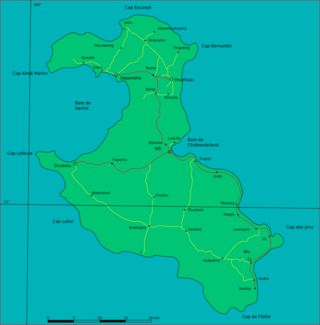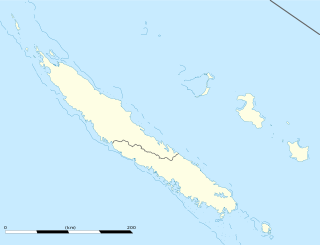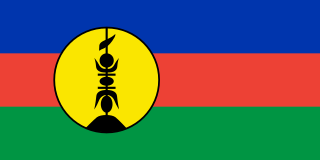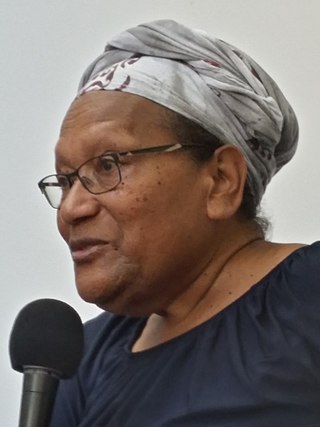
New Caledonia is a sui generis collectivity of overseas France in the southwest Pacific Ocean, south of Vanuatu, about 1,210 km (750 mi) east of Australia, and 17,000 km (11,000 mi) from Metropolitan France. The archipelago, part of the Melanesia subregion, includes the main island of Grande Terre, the Loyalty Islands, the Chesterfield Islands, the Belep archipelago, the Isle of Pines, and a few remote islets. The Chesterfield Islands are in the Coral Sea. French people, especially locals, call Grande Terre "Le Caillou". It is one of the European Union’s Overseas Countries and Territories (OCTs), but is not part of the European Union.

The geography of New Caledonia (Nouvelle-Calédonie), an overseas collectivity of France located in the subregion of Melanesia, makes the continental island group unique in the southwest Pacific. Among other things, the island chain has played a role in preserving unique biological lineages from the Mesozoic. It served as a waystation in the expansion of the predecessors of the Polynesians, the Lapita culture. Under the Free French it was a vital naval base for Allied Forces during the War in the Pacific.

Demographic features of the population of New Caledonia include population density, ethnicity, education level, health of the populace, economic status, religious affiliations and other aspects of the population.

Nouméa is the capital and largest city of the French special collectivity of New Caledonia and is also the largest francophone city in Oceania. It is situated on a peninsula in the south of New Caledonia's main island, Grande Terre, and is home to the majority of the island's European, Polynesian, Indonesian, and Vietnamese populations, as well as many Melanesians, Ni-Vanuatu and Kanaks who work in one of the South Pacific's most industrialised cities. The city lies on a protected deepwater harbour that serves as the chief port for New Caledonia.

Ouvéa or Uvea is a commune in the Loyalty Islands Province of New Caledonia, an overseas territory of France in the Pacific Ocean. The settlement of Fayaoué, on Ouvéa Island, is the administrative centre of the commune.
The thirty New Caledonian languages also known as Kanak languages form a branch of the Southern Oceanic languages. Their speakers are known as Kanaks. One language is extinct, one is critically endangered, four are severely endangered, five are endangered, and another five are vulnerable to extinction.

Lifou Island, historically spelt Lifu or Lefu in English, and known as Drehu in the local language, is the largest, most populous and most important island of the Loyalty Islands, in the archipelago of New Caledonia, an overseas territory of France in the Pacific Ocean. With a total area of 1,207 km2 (466 sq mi), Lifou is located east of Australia at 20.9°S 167.2°E.

Caldoche is the name given to inhabitants of the French overseas collectivity of New Caledonia of European ethnic origin who have settled in New Caledonia since the 19th century. The formal name to refer to this particular population is Calédoniens, short for the very formal Néo-Calédoniens, but this self-appellation technically includes all inhabitants of the New Caledonian archipelago, not just the Caldoche.
Drehu is an Austronesian language mostly spoken on Lifou Island, Loyalty Islands, New Caledonia. It has about 12,000 fluent speakers and the status of a French regional language. This status means that pupils can take it as an optional topic for the baccalauréat in New Caledonia itself or on the French mainland. It has been also taught at the Institut national des langues et civilisations orientales (INALCO) in Paris since 1973 and at the University of New Caledonia since 2000. Like other Kanak languages, Drehu is regulated by the Académie des langues kanak, founded in 2007.

Poum is a commune in the North Province of New Caledonia, an overseas territory of France in the Pacific Ocean. The small town of Poum is located in the far northwest, located on the southern part of Banare Bay, with Mouac Island just offshore. Aside from French, the native language of the Kanak inhabitants is nêlêmwa-nixumwak, an Austronesian language spoken by about 1,100 people. British fishermen came to the islands in 1855 seeking sea cucumbers, and settled and intermarried, and this is reflected in the last names of some clan members and on gravestones. In the 1850s, a hundred Europeans lived on Mouac Island and John Henry Williams established a presence on Néba island.

Maré Island or Nengone is the second-largest of the Loyalty Islands, in the archipelago of New Caledonia, an overseas territory of France in the Pacific Ocean. The island is part of the commune (municipality) of Maré, in the Loyalty Islands Province of New Caledonia.

Loyalty Islands Province is one of the three top-level administrative subdivisions of New Caledonia. It encompasses the Loyalty Islands archipelago in the Pacific Ocean, located northeast of the New Caledonian mainland of Grande Terre.

Tayo, also known as "patois de Saint-Louis", is a French-based Creole spoken in New Caledonia. It is spoken by about 3000 people in the village of Saint-Louis, about 15 km (9.3 mi) from the New Caledonian capital Nouméa. The language developed out of the contact of speakers of many different Kanak languages in the mission, and the use of French for official purposes and as the language of prestige. The language contains structural elements primarily from Melanesian languages and lexical elements mainly from French.
Xârâcùù, or Kanala, is an Oceanic language spoken in New Caledonia. It has about 5,000 speakers. Xârâcùù is most commonly spoken in the south Central area of New Caledonia in and around the city of Canala and the municipalities of Canala, Thio, and Boulouparis.

"Soyons unis, devenons frères" is the officially recognised anthem of New Caledonia. It was written by a group from the children's choir Mélodia in 2008 and officially adopted in 2010. It is not the national anthem of New Caledonia; as a special collectivity of France, the national anthem is the French national anthem, "La Marseillaise". During official ceremonies or sports events, "La Marseillaise" is performed first, followed by "Soyons unis, devenons frères".
Jawe is one of the Kanak languages spoken in the northern province of the largest island of New Caledonia named Grande Terre. Jawe speakers are located along the northeast coast of the island, north of Hienghène and south of Pouébo; primarily in the Cascada de Tao region, Tchambouenne, and in the upper valleys of both sides of the centrally dividing mountain range.
Caac or Caaàc, Caawac, Moenebeng, Mwelebeng is a Kanak language of northern New Caledonia. As of 2009, there were 1,170 reported speakers of Caac. The primary Caac-speaking population center is the village of Pouebo, which is located on the northeastern coast of Grande Terre in the region of Hoot ma Waap. Caac is classified as an Extreme Northern New Caledonian language. Its closest linguistic relatives are also its closest geographic relatives which include Nêlêmwa-Nixumwak, Yuanga and Nyâlayu.

The Kanaks are the indigenous Melanesian inhabitants of New Caledonia, an overseas collectivity of France in the southwest Pacific. According to the 2019 census, the Kanaks make up 41.2% of New Caledonia's total population — corresponding to around 112,000 people.

Déwé Gorodey was a New Caledonian teacher, writer, feminist and politician. She was active in agitating for independence from France in the 1970s. She published poetry, short stories and novels. From 1999, she was a member of the New Caledonian government, representing the pro-independence Kanak and Socialist National Liberation Front. From April 2001 to June 2009, she served almost continuously as Vice President of the Government of New Caledonia.

An independence referendum was held in New Caledonia on 4 October 2020. The poll was the second to be held under the terms of the Nouméa Accord, following a similar referendum in 2018.















